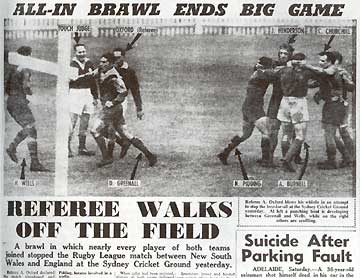NRL TEAMS - 2024 Round 7
2 days ago | LeagueUnlimited Media

In 1954, the world of rugby league was very different to today.
There was unlimited tackles (meaning you would only get the ball if the opposition team lost possession). The defence only had to retreat five metres (compared to 2017 where it is ten metres) and referees were generally more lenient towards players and their actions. In fact brawls had become a inconsistent part of rugby league in the 1950's although none could match what would happen in the post season tour match between Great Britain and New South Wales.
The 1954 New South Wales Rugby League Football season had concluded in mid-September with foundation club South Sydney recording a 23-15 defeat of the Newtown Jets to lift up the Premiership at the Sydney Cricket Ground in front of more than 45,000 spectators.
Following this was a three-match test series between Great Britain and Australia as a lead up to the 1954 World Cup which was held in France.
In between the second and third tests the Great Britain side took on a full strength New South Wales team which included Australian internationals Ken Kearney and Clive Churchill in a tour match at the Sydney Cricket Ground.
The match was played at the SCG but little did the fans in attendance know, was that they wouldn't be getting their money's worth.
Great Britain was starting to feel the affects of the previous two tests against Australia and had injuries galore (or at least that it was they made the Australian media think).
They lined up a host of forwards in the backline including hooker Tommy Harris playing prop, second rower Gunny playing at fullback and the two nuggety props Briggs and Wilkinson playing on the wings.
New South Wales was skeptical that Great Britain was not taking the game seriously and the selections seemed to justify their concerns. However it only got worse from there for the home side as all hell broke loose once the whistle for kickoff was blown.
There was a lot of niggle in the first half with the occasional fight breaking out. However nothing could prepare the fans or media for what was to transpire in the second half.
After the tense opening half, referee Aub Oxford lost control of the contest early in the second half as Great Britain started to display its frustration.
Trailing 15-3 to NSW, Oxford sent off Great Britain five-eighth Ray Price for abusing the linesman.
The next ten minutes saw a punch in every tackle as Great Britain and NSW focused less on playing football and more on maiming the opposition.
An all in erupted when English half Burnett threw a punch that missed Churchill and collected with the back of Australian winger Pidding's head. The was the trigger for all hell to break loose and all players became involved.
Frustrated with the constant brawling Oxford calmly walked from the field as players fought in the background. He had abandoned the match much to the surprise of the fans in attendance.
It would be the last time he would officiate any rugby league games.
Australian fullback Clive Churchill said many years afterwards that "the English beyond any doubt had no intention of playing football on that day".
The news was big enough to be on the front page of every newspaper in Sydney the following day.
However the British claimed that due to injuries they had to play forwards out of position. This led to the Australian players "taking the mickey" once the game got underway due to their greater pace and ability outwide.
So when the visitors got their hands on the Australians they would rough them up as best they could which ultimately led to fights in the ruck area.
After the match had concluded, fans surrounded the Great Britain dressing room hurling abuse and more than a few British players had to be restrained from going out to remonstrate with the mob.
It was reported that players from both sides attended the South Sydney's Annual Ball the night of the game, there they all had a good laugh about the game and were very apologetic. However it is still a sore point for the British due mainly to the fact that no one from the NSW team was ever made to apologise for their role in the fighting and the British were.
Even now some 60 years later, it is still one of the darkest days in Australian rugby league history.